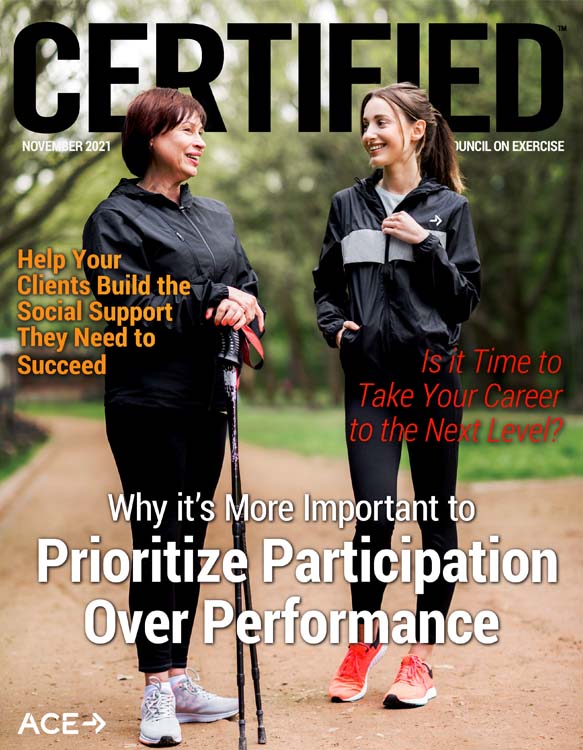
To have rapport with another individual means you have established a mutually trusting and respectful relationship in which both individuals feel understood, valued and validated. Rapport is the foundation of the client-health coach relationship. Without the existence of rapport, no collaborative partnership or behavior change coaching can occur—at least not in an effective manner.
As with behavior change, building rapport is a process that occurs over time and throughout the existence of the relationship. Rapport building begins from the moment you, as the coach, meet your client for the first time. Each interaction following the initial session is another opportunity to build upon the foundation of that relationship.
While there is no specific formula or sequence of events that all health and exercise professionals follow to build rapport, there are methods you can employ to help establish a quality relationship.
Because the building of a relationship occurs from the first contact with a new client, there are several steps you can take to prioritize the client’s comfort and engagement. Outside of being mindful of verbal and nonverbal behaviors, and mirroring the client’s voice volume, speed of talking and body language, you can establish quality front-door communication with a thoughtfully designed and comprehensive welcome packet.
The Welcome Packet
There’s no formulaic approach to creating a welcome packet. Just as each coach has their own coaching style and flair, a welcome packet should be reflective of the coach and their philosophy and approach to behavior-change coaching, and unique to their style in general. I advise new health and exercise professionals to start small with a less-is-more approach, but be sure to include the following five must-have items:
- Client welcome letter
- Lifestyle, health history, PAR-Q+, informed consent and medical release (as needed) forms
- Values in action assessment
- Expectations (such as confidentiality, openness, accountability, etc.)
- A coaching agreement (emphasis on agreement and not “contract”)
Let’s examine the value of each of these five items before discussing how to deliver the packet and any additional information you could consider including in your own welcome packet.
The Client Welcome Letter
A client welcome letter does not need to be complicated or lengthy. A simple “Welcome to the X Health Coaching experience. I’m excited to join you on this journey” approach is enough. A welcome letter helps to strengthen the line of communication from the beginning and demonstrates to the client that you value their decision to work with you. This document (unless you create a table of contents) can serve as the front or cover page.
The Forms
It is imperative that you, as the professional, collect a client’s health history, and exercise and health behavior history, as well as provide an informed consent and PAR-Q+. These forms not only protect both you and the client, but also provide critical insight into the client’s potential risk factors.
Values in Action Assessment
A values assessment can help you and your client identify their top character strengths and apply them toward meaningful behavior-change goals and efforts. Further, once you know your client’s strengths, you can help them build upon them through your work together. An example of a values assessment can be found here.
Expectations
By providing clients a list of what they can expect while working with you, you further enhance rapport and trust. Included in the list of expectations are a client’s expectation of confidentiality and privacy, a description of health coaching as a collaborative experience (as opposed to a directed approach), what a typical coaching session might involve, a brief discussion of a client-directed and client-centered approach, and your commitment to honest, open and transparent communication. Certainly, other aspects can fit within this section, and you will likely modify this as your experience grows.
Client–Coach Agreement
The client–coach agreement is a clarifying document that describes the nature of the coaching relationship. This agreement details what health coaching is (a partnership) and what health coaching is not (therapy and/or “giving” answers, for example). A well-structured and thoughtful agreement gives a client a full picture of what to expect from their experience working with you.
Coaching agreements are as varied as the personalities of the professionals and clients themselves. That said, there are necessary components you will want to include for the agreement to be sound and informative. The following are a list of items and clauses to call out within your agreement.
- How coaching is structured/offered. Here, include if you will offer sessions online, face to face or in a hybrid fashion. You can also provide information as to the length of sessions you offer to clients (this will largely depend on the client and the type of “package” they choose to enroll in with you).
- Session frequency. Explain how often you meet with clients (again, this is client-dependent) and provide a general idea of frequency. For example, once a week, three sessions a month or up to X sessions every four weeks.
- Affirmation of confidentiality. While this is introduced in your list of expectations, make sure to call out this important feature. You can also note that you follow HIPAA protocol and describe the ways in which you keep client data/information safe and secure.
- Costs/options. Clients must know what your hourly, monthly or package rates include so they can make an informed decision. If you are unsure of what to charge or how to charge (by the hour, per session, per package or other configuration), conduct some market research to determine what coaches are charging in and around your area. If you are a coach interested in offering online sessions, search that as well, as costs can differ. Here, you can also note how you accept payments (for example, PayPal, Venmo, Health Coaching app, check or cash).
- Cancellation, no-show and rescheduling practices. While this section might seem simple, be sure to provide enough detail so clients are aware of your policies and how clients will be held accountable. Here are some examples of language you might use:
Should a client need to cancel an appointment, we request that there is a 24-hour notification unless it is an emergency. [State if you will provide a refund or partial refund.] To reschedule, please [include detailed instructions or appropriate links to a scheduling software].
If a client does not show for the scheduled session, the client is responsible for the full cost of the session [or other arrangement depending on your preferences as the professional].
Should the coach need to cancel an appointment with a client due to an emergency or other unforeseen circumstance, the client is not charged for the session. The coach will contact the client to reschedule via [detail how this will be done, such as email, text, app feature, website form, etc.].
You can think of the client–coach agreement as a summary of the policies and procedures that help to keep both parties mutually accountable and on track toward success.
How Clients Can Access a Welcome Packet
The accessibility of the packet is just as important as its contents. If possible, include a variety of methods so clients have options for accessing the information. Options to consider include:
- A downloadable e-book option with editable PDFs (password protected so that only clients can access it)
- Emailed link with editable PDFs
- Hard copies upon request (some clients prefer the comfort of a tangible product over an electronic document)
- Access through a learning-management system as a module or task
Regardless of the ways you choose to make the packet available to your clients, if there are forms you need completed before the first discovery session, make sure those are given to the client in advance and provide a due date by which you need them returned. This gives the client some “homework” and allows you time to review and prepare follow-up questions.
Other Features
Remember, your relationship with your client begins from the first moment of contact. It cannot be emphasized enough that your goal is to make that first impression as positive, warm and welcoming as possible.
As you grow in your practice, session design and coaching experience, you may choose to add other items to build a more comprehensive welcome packet. It’s important to note the environment in which you work (clinical, private, etc.), as this will influence the process by which you respond to prospective client inquiries and take on new clients.
In addition to the items listed in the “must haves,” I include the following items in my welcome packet for my own clients:
- My professional philosophy statement (included below as an example) along with a list of my credentials and professional background:
I believe in the power of a holistic approach to healthy living. Living an active and healthy lifestyle is not defined or limited by physical stamina, muscle size, or outward appearance. An active and healthy lifestyle is multifaceted and requires commitment and balance in all aspects of personal wellness. Being fit means finding an equilibrium between the physical, social, intellectual, environmental, occupational, and spiritual dimensions of personal well-being. I am personally and professionally dedicated to teaching students and clients how to achieve such balance through learning and focused skill development. It’s not simply about “hitting the gym;” it’s about discovering inner strength, harnessing personal potential, and exercising the courage to pursue a meaningful goal.
- Contact information and methods of contact (email, business phone number, personal zoom link)
- Menu of services (personalized and goal-driven workout design, nutrition coaching, and health coaching). Note: Your menu will depend on your personal list of credentials.
- SMART-ER Goal Setting Worksheet (a tool I developed, which is included above as a password-protected bonus for ACE Certified Professionals)
- Outline of what a coaching session will look and feel like
- Client information/data form
- Wellness Inventory (this is a tool from the National Wellness Institute that allows clients to evaluate the various “pieces” of their wellness picture)
The initial session is likely the most significant interaction you will have with a new or potential client, so take the time to make it a meaningful, engaging and empathetic experience. This first interaction serves as the foundation of the relationship. As a coach, you must employ the necessary tools to create a sense of safety in the conversation so that the client feels empowered rather than vulnerable, guided as opposed to directed, and seen as well as heard.
Much like your philosophy of coaching, the client welcome packet you develop and deliver will remain fluid and evolve as you learn, grow, develop new skills and uncover new insights. Review it as often as you review your business plan and strategic goals to ensure relevancy and to prioritize best practice.





 by
by 


